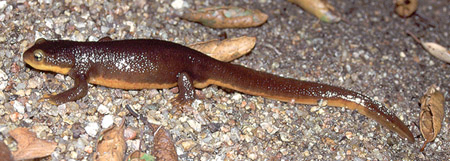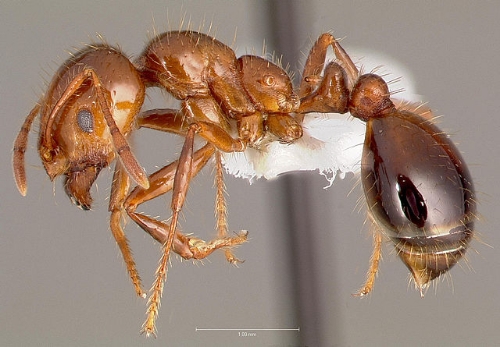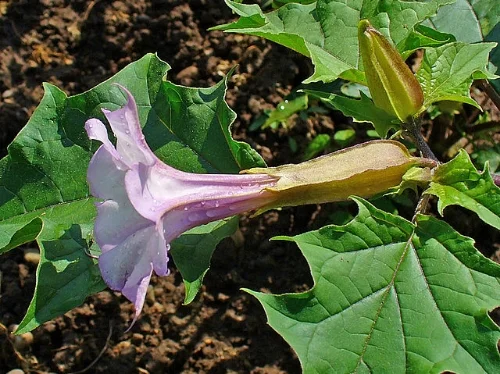Earlier this week the discovery of a small tick boring into my calf muscle had me researching other terrifying flora and fauna that I need to watch out for as I acclimate to Los Angeles. Actually, aside from ticks, I find pretty much all of nature fascinating. Ticks just suck.
Here are 30 fascinating plants and animals in southern California that can cause anything from minor irritation (skin rash) to major irritation (death):
California's Toxic Animals:
1. Black Widow Spider
According to the L.A. Natural History Museum, black widow spiders are common and plentiful in southern California. Avoiding nature won't help- these guys live downtown too. Famous for its red hourglass-shaped marking, the black widow has large fangs that can inject a strong toxin into flesh. Unfortunately, identification isn't always easy as the ubiquitous hourglass isn't present on males or juveniles. Fortunately, bites are treatable and rarely deadly, but still make for a very bad day. Seek medical help if bitten.
While black widows are native to California, the brown widows is a newcomer to the scene and appear to be overtaking their deadly cousin. Familiarize yourself with the markings of the brown widow. Their bites are less toxic, but still not fun.
2. American Dog Tick
Commonly referred to as a wood tick, the American dog tick can be a carrier of the pathogens that cause Rocky Mountain Fever or tularemia. It's generally not a carrier of the Lyme disease pathogen. However, in California, Lyme disease can be spread by the Western Black-Legged tick. All tick bites should be disinfected and, if a rash develops, medical attention sought. By the way, don't assume ticks are only found in the woods. They're readily found in urban areas where there is vegetation and food (i.e. you and your dog).
3. Bark Scorpion
According to the University of California-Davis, this is the only truly dangerous scorpion in the state. Luckily most Californians won't ever see one in the wild, as they are limited to a small range along the Arizona border. While you generally don't want to mess with any scorpion, this one is particularly nasty. Though scorpion stings are fairly common in the American southwest, deaths are extremely rare. Still, if a sting results in physical symptoms, save the specimen and see a doctor.
4. Gila Monster
Another creature that tends to live close to the Arizona border is the gila monster. Growing up to two feet in length, this lizard would be a fascinating find on a desert hike. But don't get too close- their strong bite can release a small amount of very painful (though not deadly) toxin.
5. California Newt
California newts are pretty adorable...until you pick them up. Their skin contains toxins that can kill animals and even humans if ingested. They are located throughout California, though populations are declining due to habitat loss and predation. Look, but don't touch and don't harm.
6. Western Diamondback Rattlesnake
According to the San Diego Natural History Museum, "The Western Diamondback is a stubborn snake and has a tendency to stand its ground. As with all rattlesnakes, this species is venomous. It ranks as one of the most dangerous snakes in the world. Bites are serious and potentially deadly if medical treatment is not reached immediately."
Other rattlesnakes potentially found in California include the Red Diamondback rattlesnake, the Southern Pacific rattlesnake, the Speckled rattlesnake, and #7 on the list, which has been a particular newsmaker:
7. Mojave Green Rattlesnake
In 2012, this particularly feisty rattler made headlines when its bite critically injured a boy who was camping with his family.
But as KCET reporter Chris Clarke notes, "...the snake has to bite you in order to deliver that venom cocktail, and even Mojave greens -- which have a reputation for aggressiveness -- would really prefer not to bite anything larger than a rabbit, given the choice. The vast majority of rattlesnake bites occur in situations in which a person is deliberately handling the snake, or trying to. Left to their own devices, they tend to leave us to ours."
8. Sidewinder
Commonly known as the "sidewinder", this rattlesnake common to the American southwest is actually in the pit viper family. Unique for the "S" or "J" shaped pattern left in the sand as it winds through the desert, this snake does have a venomous bite. Though less toxic than other California rattlers, it can cause a list of painful and injurious symptoms. Like all snakes on this list, a rattlesnake doesn't seek out human prey. Snakes are more likely to shy away from humans but may bite when provoked—though, generally not without first sounding off with its noisy tail. Bites must receive medical attention.
9. Yellow-Bellied Sea Snake
The last snake on the list is included more for its uniqueness than its local prevalence. The yellow-bellied sea snake is uncommon in California, with few sightings in recent years along the Pacific coast. It is, however, considered one of the most prolific snakes in the world. Out in the ocean, they can be found in great masses. Avoid when boating, swimming, or exploring tide pools, as their bite contains a small amount of highly toxic venom. Immediate medical treatment is essential.
In 2015 and 2016, individuals washed up on beaches in Coronado and Huntington Beach.
10. Stingray
Since we're talking about the sea, let's explore a few more scary swimmers. Stingray injuries are common on some of California's most popular beaches. While not deadly, the stings are extremely painful and can lead to infection if wounds are not cleaned. Round rays are the most common species in California, while Bat rays are also known to sting. Stings usually occur when a beachgoer's foot encounters the soft skin of a ray resting on the sea floor. See a lifeguard or leave the beach to clean the wound.
11. California Scorpionfish
Spines on the fins and gills of this species of rockfish contain a toxic pain-inducing venom. According to California Department of Fish & Wildlife, enough venom can even cause systemic distress requiring hospitalization. It is therefore one of the most dangerous fish off the coast of California and one regularly encountered by fishermen.
12. Sharks
Quite unlike the rattlesnakes mentioned above which only strike if provoked, sharks are widely known to intentionally attack an unsuspecting swimmer, surfer, or fisherman. According to a January 2015 L.A. Times article, "there were six unprovoked shark attacks along the U.S. Pacific Coast in 2014. All of them were in California, and all the sharks were great whites."
Along with the great white, the Mako shark (pictured above), is a California resident that has been known to attack humans, though it has no record of recent attacks in California. Even when a shark doesn't kill its victim, that doesn't mean the injured is out of the water just yet. According the Florida Sun Sentinal, "The scariest thing about a shark's mouth — aside from the teeth — is the bacteria." Shark bites, however small, must be examined by a medical professional.
13. Mosquito
The Center for Disease Control recorded 787 cases of West Nile virus in California for 2014. That number just happens to be close to the same number of rattlesnake bite calls the California Poison Control Center receives each year. Rattlesnakes are usually avoidable, but a mosquito bite can happen without you even knowing. That makes them a contender for one of the most toxic and widespread creatures on the list. According to the L.A. Times, 31 West Nile cases last year were fatal and 561 resulted in some form of neurological complication. That's scary stuff. Here is the CDC's West Nile website, which provides prevention tips and symptom information.
The latest mosquito-borne health scare is the Zika virus. Carried by the invasive Aedes mosquito, a case of Zika within California has yet to be officially diagnosed but health officials are concerned about the presence of this aggressive bug in numerous counties throughout the state.
14. Africanized Bee
True, any bee sting can be painful and lead to allergic reaction, but the Africanized "killer" bee is particularly brutal in its approach. And as KPCC reported, they've spread throughout SoCal: “Around the L.A. County area, I would imagine that if you just see a wild bee or a bee that you encounter on a flower or something like that, there’s a greater than 50 percent chance that it’s Africanized,” said James Nieh, a biology professor who studies bees at the University of California San Diego."
Africanized bees look like any other bee but, when bothered, they respond like none other. UC-Riverside explains, "Africanized bees defend their colonies much more vigorously than do European bees. The colonies are easily disturbed (sometimes just by being nearby). When they do sting, many more bees may participate, so there is a danger of receiving more stings. This can make them life threatening...Once disturbed AHB will continue the attack for a long distance." A swarm attack can result in thousands of stings and usually requires hospitalization. Human deaths, however, are generally rare with only a couple, on average, occurring each year throughout the nation (pet deaths are more common).
15. Red Imported Fire Ants
In the late 1990's the invasive Red Imported Fire Ant began spreading across southern California. Eradication programs were put into effect, but have not eliminated the pest. The ants sting in great numbers and, similar to bee stings, can cause severe or fatal allergic reactions. Fire ants also do costly damage to California's agriculture industry.
California's Toxic Plants:
16. Pacific Poison-oak
Identifiable by its 3-leaf clusters growing as vines or shrubs, the Pacific poison-oak is widespread and problematic throughout California. According to UC-Davi's Statewide Integrated Pest Management Program, "Poison-oak is considered one of the most hazardous plants in the western United States. Its milky, poisonous oil, containing a compound called urushiol, can cause a severe skin rash."
17. Datura (aka Jimsonweed, Angel's Trumpet)
Its trumpet-like flowers look innocent enough, but in reality they play a sinister tune. Datura stramonium is known by many (and ingested by a few) for its hallucinogenic effects. But the smallest intake can lead to a long list of strong and even bizarre side-effects that can take days or even weeks from which to recover. This weed is all over California and you'd be well-advised to avoid experimenting with its psychedelic reputation.
Brugmansia, a relative of datura, is not native to California but is widely used as an ornamental shrub or tree. It too goes by the name Angel's Trumpet and is also toxic. Their heavy clusters of yellow, pink, or white flowers are seen all over yards in southern California.
18. Stinging Nettle
It's not always cut-and-dried as to which plants are poisonous and which plants are beneficial. The stinging nettle, for instance, has a long history of being used domestically for anything from skin care to tea. But harvest the fresh nettle without gloves and you'll likely get—you guessed it—stung. The plant is covered with thin needle-like hairs that inject several toxins when touched. The result is very itchy and bumpy skin.
19. Lantana
Lantana is a popular ornamental non-native shrub found in yards and pots everywhere in California. Butterflies love it, but you better keep your own proboscis away- it's toxic to humans.
20. Poodle-dog Bush
Maybe it got its name because it will attack your ankles if you get too close. A native Californian with stinky but pretty purple flowers, Eriodictyon parryi causes blisters for weeks if you touch it. Like a cute little poodle, looks can be deceiving.
21. Silver Lupine
Another California native, another purple flower, another deception. This one's toxicity causes birth defects in cattle, of all things! On the other hand, this lupine is essential to the survival of the endangered Mission Blue Butterfly. So plant wild lupine far and wide...unless you're a cattle rancher.
24. Foxglove
Well, well, well, isn't this interesting, three purple charlatans in a row. Like the lupine above, the foxglove is both deadly and life-giving. To humans and pets, it can cause severe reactions when consumed. On the other hand, it contains the chemical compound digitalis which is used in medicine to treat heart problems. So don't swallow this one unless it comes in pill form from your doctor. Foxglove isn't a native plant, but it's a beautiful invasive that attracts hummingbirds and butterflies.
25. Oleander
The beloved non-native Oleander has long been a southern California mainstay. The hardy shrubs are the go-to choice for shopping centers and municipalities looking for a zero maintenance shrub. In the early 1990's, a blight brought on by the glassy-wing sharpshooter leafhopper wiped out most of the state's oleander. Though the plant has rebounded tremendously, there's no cure for the blight so shrubs sometimes die after 3-5 years. Oh, by the way, Oleander is deadly. Well, that might be a bit dramatic. If you ingest oleander you get so sick you might just wish you were dead.
26. Western Destroying Angel
Here we have one of the most deadly organisms in the United States. You'd think the name would make people more wary of accidentally eating this mushroom (Amanita ocreata) but, along with its cousin the "Death Cap" (Amanita phalloides), they still kill in California. You name the awful symptom—amanita causes it. I suppose death isn't so much a symptom as it is the result of experiencing all the symptoms. But here's the story of a man who survived a 'destroying angel' poisoning...barely.
27. Green-spored Parasol Mushroom
Because it has similar looking edible cousins, the Chlorophyllum molybdites mushroom is commonly eaten by mistake. Though it probably won't kill you, you'll definitely know you've made the mistake. Think gastrointestinal disturbance on a grand scale.
28. Western Jack-O'-Lantern Mushroom
Called "false chanterelle", coming across a stump full of these orange beauties no doubt excites the novice mushroom hunter. But alas, Omphalotus olivascens is a cruel mistress. If you eat this jack-o'-lantern, you've been tricked and what you're about to experience is surely no treat.
29. Flower Pot Parasol
So you bought brand new soil for your brand new plant, you followed all the rules, then this happens. Some crazy yellow mushroom pops up that you had no intention of growing! Relax- it happens to everybody. Leucocoprinus birnbaumii likes the warm moist soil of your indoor flowerpot. Or, if you're in southern California, your outdoor flowerpot. Just don't get any ideas that you've found your new calling as a mushroom farmer. These things are toxic and will make you sick to your stomach. Since they're so common indoors, pluck them out of your pots so that they don't tempt nibbling kids and pets.
30. Deadly Galerina
I saved this one for last because it has the word "deadly" in its name. Actually, Galerina marginata hasn't killed too many people. Just a few. It's an important part of the forest ecoysystem because it helps break down (rot) fallen trees. In humans, gut rot is more like it.
Myths & Misperceptions:
Tarantulas:
They are big and hairy and therefore scary, right? Nah, as KQED reports, they are "gentle giants". Their bite is kind of like a bee sting if provoked, but more often than not they just mind their own business. On the other hand, where there are tarantulas there are tarantula hawks. These wasps aren't out for your blood, they specifically prey on tarantulas. But if you do decide to mess with one and it stings you, the result is "…immediate, excruciating pain that simply shuts down one's ability to do anything, except, perhaps, scream." (via Wikipedia).
Brown Recluse Spiders:
Let's just shut down this myth once and for all, shall we? Entomologist Rick Vetter at U-C Riverside writes, "The biological evidence that is available resoundingly deflates any of the arachno-propaganda that is constantly being given new life with each newspaper story or word-of-mouth tale of terror. I emphatically state THERE ARE NO BROWN RECLUSE SPIDERS LIVING IN CALIFORNIA."
Jellyfish:
Though jellyfish populations, like the large black jellyfish, are on the rise in California waters, our local species are not serious enough to warrant listing on the toxic 30. There are reports of stings each summer, but they're relatively mild compared to other poisonous jellyfish and easily treated with a vinegar solution.
--- --- --- ---
Just because humans may perceive a plant or an animal as frightening, doesn't mean it must be exterminated. Every living organism is serving a purpose so we must co-exist. We can do that by being AWARE:
Accept that humans don't have more right to exist than other creatures. We must all co-exist.
Witness the natural world with curiosity and compassion
Ask about the unknown
Relocate rather than exterminate
Educate yourself, then educate others on what you've learned
















![Pacific Poison-oak in autumn // Credit: By Gregg Erickson (Own work, by Gregg Erickson) [Public domain], via Wikimedia Commons](https://images.squarespace-cdn.com/content/v1/53d81d26e4b056bffaa2e0d2/1433462833326-4VM2LLCTCBMGXH7XN1CT/Pacific-Poison-Oak.jpg)




![Silver Lupine // Credit: By C T Johansson (Own work) [CC BY-SA 3.0 (http://creativecommons.org/licenses/by-sa/3.0)], via Wikimedia Commons](https://images.squarespace-cdn.com/content/v1/53d81d26e4b056bffaa2e0d2/1433475587689-U2OQOTNBGFIJ5TWHFGPI/lupine)
![Foxglove // Credit: By AnemoneProjectors (Flickr: Foxglove (Digitalis purpurea)) [CC BY-SA 2.0 (http://creativecommons.org/licenses/by-sa/2.0)], via Wikimedia Commons](https://images.squarespace-cdn.com/content/v1/53d81d26e4b056bffaa2e0d2/1433518857314-ZK3FJ3O0ATHN86ND10QF/512px-Foxglove_%28Digitalis_purpurea%29.jpg)





